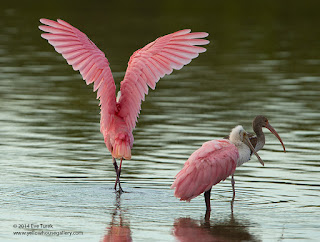Q: What in the world is a Loon doing, trying to walk beside
the bike path along Duck Road in Southern Shores?!?
A: Nothing that will result in its survival!
Loons, like gannets, are marvelously engineered for a life
on the water, but their legs and feet are set too far back to allow them to
successfully take off in flight from dry land. They need water not only to feed
but also to get airborne.
I passed by the bird which was sort of dragging itself
forward at about 6:25 pm and realized as I drove by what I had seen. Or to be
more accurate, I questioned what I had just seen, so I quickly found a place to
turn around and double check. Sure enough, the bird was a loon and in obvious
distress. Hold on, I said out loud, as I drove past the second time. I’m coming
to get you.
Cars were whizzing by but the bird at that moment was very
near the fork in Southern Shores where the road splits and where there is a
small parking area. I turned there and parked, my mind already trying to
visualize what was in the back of the car that I could use. Normally I carry at
least one towel for critter rescue, but my vehicle has been full of boxes
transporting inventory and supplies between SeaDragon Gallery, our new gallery
in Duck, and Yellowhouse Gallery in Nags Head. I’d removed a lot of the
paraphernalia I keep in the car “just in case.” Well, here was a case. Now
what?
I did have a thin waterproof pullover. It would have to do.
Years ago, artist friend E.M. Corsa and I rescued a Northern Gannet, so I know
the general drill: try to get close enough without spooking the bird in order
to place a towel (read, pullover) over its head and gently scoop it up in a way
that doesn’t hurt either the bird’s wings or you. I had never tried this alone. As I was getting out of my car, a
jogger passed by but the bird had frozen its motion and tucked its head down. I
don’t think the jogger even noticed. I approached slowly and talked softly as I
knelt down nearby. I hoped my calm outer demeanor would keep the bird calm. It
eyed me but didn’t try to move. I called my friend for reassurance and covered
the bird, carrying it gently in my arms back toward my car. A couple of drivers figured out I was
carrying something that needed help and stopped to let me cross. I put the loon
on the floor of the passenger seat (my friend’s advice) – and it looked up at
me and gave its haunting, trilling call.
I’ve never heard that call in person before, and I took it as a sign I
was doing the right thing.

I drove back north to the Duck Boardwalk. Near our shop is a set of stairs that
leads right to the water. Alas, the gate at the top of the stairs was locked!!
By this time, the loon was trying to move inside the pullover and straining its
head back and forth. Did it sense the water? Was it alert to the smells and
sounds of the Canada Geese nearby? I tucked it even closer to my body with my
left hand and stroked its head with my right, crooning to it all the while.
There was a dock facing west just a little way down the boardwalk. Off we went.
When I reached the dock, the closest pier to the water’s
surface was still about a foot or foot and a half above it. I took a deep breath, unwrapped the
loon, and gently let it go as close to the water as I could. It dropped with a
big splash but came right back up to the surface and immediately began swimming
around past the dock and out into more open water, ducking its head under the
water, rising and stretching its wings, and diving under the surface only to
bob up again a few feet away.
I left it as the evening sun began its last
descent before the sky turned pink and wished it well.
Its wings appeared to be functioning just fine. It must not
have been out of water so long as to be totally exhausted. How in the world it
wound up on the bike path I will never know. What I do know is that we were
both in the right place at the right time for our own life paths to intersect.
This is my joy: to interact with nature in ways that are
respectful, peaceful, loving and honoring, and to share the stories of those
interactions, those connections. What
began as another happy, busy working day ended with almost mystical overtones:
I held a loon, it crooned to me, I set it free. Life is good.





























